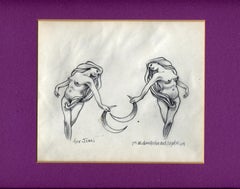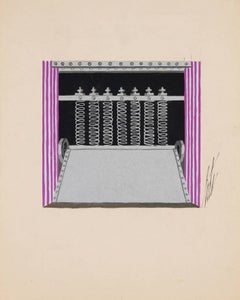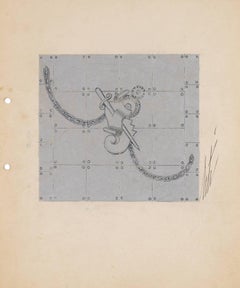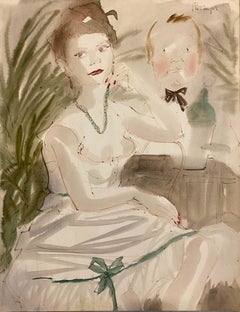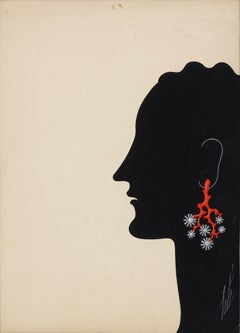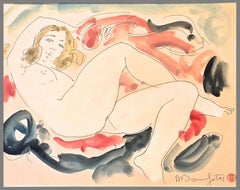Art Deco Drawings and Watercolor Paintings
to
3
3
3
2
3
2
3
1
1
Overall Height
to
Overall Width
to
510
210
125
76
36
35
24
13
5
4
3
3
3
2
2
1
1
1
1
1
1
1
2
407
46
2
13
88
83
42
21
5
10
7
3
2
1
3
3
2
2
2
Style: Art Deco
Period: 1960s
Rolling Stones original 1969 Naked Lady drawing from the Concert tour Poster
Located in Southampton, NY
A new coffee table book has just been released titled "Poster Child" The Psychedelic Art & Technicolor Life of David Edward Byrd. This original drawing is featured on page 104 of the...
Category
1960s Art Deco Drawings and Watercolor Paintings
Materials
Vellum, Pencil
Jimi Hendrix 1969 original vintage art U.S. Tour Moon Maidens
Located in Southampton, NY
This is the Original 1969 drawing of the two nude figures that appear on the Jimi Hendrix Spring 1969 concert poster. It is as much of a collectors item as it is a fine work of art. This was given to Hendrix to approve the art for the final poster. You can see images of the full 1969 poster in this listing. David Byrd referred to these women as "Moon Maidens" The art is Pencil on iridescent tracing paper, Matted with it's original "Electric Purple" matt, as done by David Byrd. The original drawing of this full image was used for the 1969 Spring U.S concert tour and it was also used as the image for Hendrix's press kit in 1969 which was given to concert promotors to advertise the concert. David met with Jimi to approve his original drawing. The art measures 7 x 8", and the matted and framed art measures approx. 15x16".
David created ALL of the Art for Bill Graham’s Fillmore East, including their Program covers and Rock posters...
Category
1960s Art Deco Drawings and Watercolor Paintings
Materials
Vellum, Pencil
Machenerie - Décor de scène. Romain de Tirtoff
Located in Tel Aviv - Jaffa, IL
Original one-of-a-kind gouache
Hand signed
Category
1960s Art Deco Drawings and Watercolor Paintings
Materials
Gouache
Métal - Projet de rideau. Romain de Tirtoff
Located in Tel Aviv - Jaffa, IL
Original one-of-a-kind gouache
Hand signed
Category
1960s Art Deco Drawings and Watercolor Paintings
Materials
Gouache
Au Bar
Located in Los Angeles, CA
PHILIPPE NOYER
"AU BAR"
WATERCOLOR, SIGNED
FRANCE, C.1960S
25.5 X 19.5 INCHES
Philippe Henri Noyer
1917-1985
Philippe Henri Noyer was born on June 28, 1917 in Lyons, France. After a traditional education at the elite Ecole des Roches, Noyer enrolled in the Ecole des Beaux Arts in Lyon. Next he moved to Paris, where he worked in decorative arts and advertising. It was during this time, he discovered his talent for oil painting, officially starting his painting career in 1943.
That same year, Noyer met the famed Parisian art deal, Emmanuel David, who would promote his work and career. Noyer produced many portraits, for which he quickly gained an international reputation, but he also painted dream figures in rural or maritime settings, compositions that were classical in technique but surreal in concept. In 1947, Noyer held his first one-man show at the prestigious Drouant-David Gallery in Paris.
In 1949 the gallery consigned twenty of Noyer’s paintings to an American art dealer who had agreed to organize an exhibition of them in the United States. However the American dealer sold the paintings at cost, in order cover a gambling debt, to Robert Goldstein...
Category
1960s Art Deco Drawings and Watercolor Paintings
Materials
Watercolor
Related Items
Disegno figurativo allegorico italiano stile Decò della prima metà del XX secolo
Located in Florence, IT
Il disegno in questione rappresenta una figura figura femminile nuda in piedi con le braccia alzate, in una posa solenne come fiero è il suo sguardo, ai cui piedi sta sdraiata una fi...
Category
1930s Art Deco Drawings and Watercolor Paintings
Materials
Paper, Color Pencil
Boucles D'oreilles En Corail By Erté
Located in New Orleans, LA
Erté (Romain de Tirtoff)
1892-1990 | Russian-French
Boucles d'oreilles en corail
(Coral Earrings)
Signed “Erté” (lower right)
Inscribed “n°3544 / Boucles d'oreilles en corail et tu...
Category
20th Century Art Deco Drawings and Watercolor Paintings
Materials
Gouache, Paper
Female Sexual Nude
Located in Miami, FL
Sotheby's New York . work is elegantly matted and framed with the Sotheby's sticker on verso
Category
1920s Art Deco Drawings and Watercolor Paintings
Materials
Pencil
The Abduction of the Sabine Women , a Renaissance drawing by Biagio Pupini
Located in PARIS, FR
This vigorous drawing has long been attributed to Polidoro da Caravaggio: The Abduction of the Sabine Women is one of the scenes that Polidoro depicted between 1525 and 1527 on the façade of the Milesi Palazzo in Rome. However, the proximity to another drawing inspired by this same façade, kept at the Ecole des Beaux-Arts, and to other drawings inspired by Polidoro kept at the Musée du Louvre, leads us to propose an attribution to Biagio Pupini, a Bolognese artist whose life remains barely known, despite the abundant number of drawings attributed to him.
1. Biagio Pupini, a Bolognese artist in the light of the Roman Renaissance
The early life of Biagio Pupini, an important figure of the first half of the Cinquecento in Bologna - Vasari mentions him several times - is still poorly known. Neither his date of birth (probably around 1490-1495) nor his training are known. He is said to have been a pupil of Francesco Francia (1450 - 1517) and his name appears for the first time in 1511 in a contract with the painter Bagnacavallo (c. 1484 - 1542) for the frescoes of a church in Faenza. He then collaborated with Girolamo da Carpi, at San Michele in Bosco and at the villa of Belriguardo.
He must have gone to Rome for the first time with Bagnacavallo between 1511 and 1519. There he discovered the art of Raphael, with whom he might have worked, and that of Polidoro da Caravaggio. This first visit, and those that followed, were the occasion for an intense study of ancient and modern art, as illustrated by his abundant graphic production.
Polidoro da Caravaggio had a particular influence on the technique adopted by Pupini. Executed on coloured paper, his drawings generally combine pen, brown ink and wash with abundant highlights of white gouache, as in the drawing presented here.
2. The Abduction of the Sabine Women
Our drawing is an adaptation of a fresco painted between 1525 and 1527 by Polidoro da Caravaggio on the façade of the Milesi Palace in Rome. These painted façades were very famous from the moment they were painted and inspired many artists during their stay in Rome. These frescoes are now very deteriorated and difficult to see, as the palace is in a rather narrow street.
The episode of the abduction of the Sabine women (which appears in the centre of the photo above) is a historical theme that goes back to the origins of Rome and is recounted both by Titus Livius (Ab Urbe condita I,13), by Ovid (Fasti III, 199-228) and by Plutarch (II, Romulus 14-19). After killing his twin brother Romus, Romulus populates the city of Rome by opening it up to refugees and brigands and finds himself with an excess of men. Because of their reputation, none of the inhabitants of the neighbouring cities want to give them their daughters in marriage. The Romans then decide to invite their Sabine neighbours to a great feast during which they slaughter the Sabines and kidnap their daughters.
The engraving made by Giovanni Battista Gallestruzzi (1618 - 1677) around 1656-1658 gives us a good understanding of the Polidoro fresco, allowing us to see how Biagio Pupini reworked the scene to extract this dynamic group.
With a remarkable economy of means, Biagio Pupini takes over the left-hand side of the fresco and depicts in a very dense space two main groups, each consisting of a Roman and a Sabine, completed by a group of three soldiers in the background (which seems to differ quite significantly from Polidoro's composition).
The balance of the drawing is based on a very strongly structured composition. The drawing is organised around a median vertical axis, which runs along both the elbow of the kidnapped Sabine on the left and the foot of her captor, and the two main diagonals, reinforced by four secondary diagonals. This diamond-shaped structure creates an extremely dynamic space, in which centripetal movements (the legs of the Sabine on the right, the arm of the soldier on the back at the top right) and centrifugal movements (the arm of the kidnapper on the left and the legs of the Sabine he is carrying away, the arm of the Sabine on the right) oppose each other, giving the drawing the appearance of a whirlpool around a central point of support situated slightly to the left of the navel of the kidnapper on the right.
3. Polidoro da Caravaggio, and the decorations of Roman palaces
Polidoro da Caravaggio was a paradoxical artist who entered Raphael's (1483 - 1520) workshop at a very young age, when he oversaw the Lodges in the Vatican. Most of his Roman work, which was the peak of his career, has disappeared, as he specialised in facade painting, and yet these paintings, which are eminently visible in urban spaces, have influenced generations of artists who copied them abundantly during their visits to Rome.
Polidoro Caldara was born in Caravaggio around 1495-1500 (the birthplace of Michelangelo Merisi, known as Caravaggio, who was born there in 1571), some forty kilometres east of Milan. According to Vasari, he arrived as a mason on the Vatican's construction site and joined Raphael's workshop around 1517 (at the age of eighteen according to Vasari). This integration would have allowed Polidoro to work not only on the frescoes of the Lodges, but also on some of the frescoes of the Chambers, as well as on the flat of Cardinal Bibiena in the Vatican.
After Raphael's death in 1520, Polidoro worked first with Perin del Vaga before joining forces with Maturino of Florence (1490 - 1528), whom he had also known in Raphael's workshop. Together they specialised in the painting of palace façades. They were to produce some forty façades decorated with grisaille paintings imitating antique bas-reliefs.
The Sack of Rome in 1527, during which his friend Maturino was killed, led Polidoro to flee first to Naples (where he had already stayed in 1523), then to Messina. It was while he was preparing his return to the peninsula that he was murdered by one of his assistants, Tonno Calabrese, in 1543.
In his Vite, Vasari celebrated Polidoro as the greatest façade decorator of his time, noting that "there is no flat, palace, garden or villa in Rome that does not contain a work by Polidoro". Polidoro's facade decorations, most of which have disappeared as they were displayed in the open air, constitute the most important lost chapter of Roman art of the Cinquecento. The few surviving drawings of the painter can, however, give an idea of the original appearance of his murals and show that he was an artist of remarkable and highly original genius.
4. The façade of the Milesi Palace
Giovanni Antonio Milesi, who commissioned this palace, located not far from the Tiber, north of Piazza Navona, was a native of the Bergamo area, like Polidoro, with whom he maintained close friendly ties. Executed in the last years before the Sack of Rome, around 1526-1527, the decoration of Palazzo Milesi is considered Polidoro's greatest decorative success.
An engraving by Ernesto Maccari made at the end of the nineteenth century allows us to understand the general balance of this façade, which was still well preserved at the time. The frescoes were not entirely monochrome, but alternated elements in chiaroscuro simulating marble bas-reliefs and those in ochre simulating bronze and gold vases...
Category
16th Century Art Deco Drawings and Watercolor Paintings
Materials
Ink, Gouache, Pen
Art Deco Costume Design - Eva
Located in Miami, FL
The paper in some of these photos looks overly textured due to the sharpness of the high-res digital camera.
In person, with the human eye, the paper looks reasonably smooth with out blemishes.
For this fashion illustration, Georges Lepape paints a stunning abstract pattern for the subject dress that is repeated in her hair. The work represents an early use of metallic paint, with silver metallic in the dress and bronze metallic in the blouse. Lepape's highly detailed drawing becomes more evident the closer you look. It's quite amazing how deftly he rendered facial feature on such a small scale. "Eva" 1918 Gouache, watercolor, and ink on paper Signed and dated, lower right: '1918' Inscribed, verso: "Costume for L'enfantement du mort, (miracle en pourpre, et or.). Devised by Marcel L'Herbier and performed at the Théatre Edouard VII and the Comédie des Champs-Elysées, 1919" Provenance: Ex-collection Lucien...
Category
1910s Art Deco Drawings and Watercolor Paintings
Materials
Ink, Gouache, Paper, Watercolor, Pencil
La Traviata - Dancer of the Bohemian Ballet - 3rd Act - Drawing by Erté - 1948
By Erté
Located in Roma, IT
La Traviata - Dancer of the Bohemian Ballet - 3rd Act is a modern artwork realized in 1948 century by Erté (Romain de Tirtoff).
Mixed colored gouache on ...
Category
1940s Art Deco Drawings and Watercolor Paintings
Materials
Gouache
H 14.57 in W 11.03 in D 0.12 in
Art Deco British watercolour drawing, William Barribal 'See my coat tails flying
Located in Petworth, West Sussex
A delightful art deco watercolour colour painting with a light touch by the British Art Deco designer and illustrator William Henry Barribal.
By the turn of the 20th century, Barr...
Category
20th Century Art Deco Drawings and Watercolor Paintings
Materials
Paper, Pencil, Gouache, Watercolor
French School, Academic Study (Male Nude)
Located in London, GB
Pencil on paper, dated (lower right), 55cm x 44cm (76cm x 64cm framed)
Drawings and paintings of the nude were central to academic art training in Europe from the 16th century onwar...
Category
1850s Art Deco Drawings and Watercolor Paintings
Materials
Carbon Pencil, Paper
Freya (Seated Backwards), Mixed media on grey board
Located in London, GB
Howard Tangye (b.1948, Australia) has been an influential force in fashion for decades. Lecturing at London’s Central Saint Martins for 35 years, including 16 years as head of BA Wom...
Category
2010s Art Deco Drawings and Watercolor Paintings
Materials
Other Medium, Archival Paper, Handmade Paper, Pen, Felt Pen, Permanent M...
Draft 4 - Polish Young Art, Realism, Drawing, Woman, Monochromatic
Located in Warsaw, PL
ALEKSANDRA KALISZ
Born in Gdynia in 1992. She currently lives and works in Portugal. She graduated from the Academy of Fine Arts in Gdansk in the studio of Professor Maciej Swieszews...
Category
2010s Art Deco Drawings and Watercolor Paintings
Materials
Pencil, Paper
Male Torso
By John Koch
Located in London, GB
Pencil, coloured pencil and chalk on paper, titled (lower left), signed (lower right), 31cm x 46cm, (51cm x 68cm framed).
John Koch was an American painter and teacher, and an impo...
Category
1950s Art Deco Drawings and Watercolor Paintings
Materials
Paper, Chalk, Pencil, Color Pencil
Dancer Study
By Christian Bérard
Located in London, GB
Pen and ink on paper, 27cm x 20cm, (54cm x 48cm framed). Provenance: Alexander Iolas Gallery, New York.
Bérard, an artist, fashion illustrator and de...
Category
1930s Art Deco Drawings and Watercolor Paintings
Materials
Paper, Pen
Previously Available Items
Lettres à Jean Marais dessin de la page 482
By Jean Cocteau
Located in CANNES, FR
"mon Jeannot " , signed and dated 29 may 1961 .
original drawing on letter certified by Madame Annie Guedras .
Category
1960s Art Deco Drawings and Watercolor Paintings
Materials
Felt Pen
Lounging Nude
Located in Los Angeles, CA
ALAIN BONNEFOIT
"NUDE ALLONGE"
WATERCOLOR, SIGNED
FRANCE, C.1960
13.5 X 17.5 INCHES
Alain Bonnefoit
Born 1937
Bonnefoit was born on May 18, 1937 in Paris. Bonnefoit paints in ...
Category
1960s Art Deco Drawings and Watercolor Paintings
Materials
Watercolor, Archival Paper
Art Deco drawings and watercolor paintings for sale on 1stDibs.
Find a wide variety of authentic Art Deco drawings and watercolor paintings available for sale on 1stDibs. Works in this style were very popular during the 21st Century and Contemporary, but contemporary artists have continued to produce works inspired by this movement. If you’re looking to add drawings and watercolor paintings created in this style to introduce contrast in an otherwise neutral space in your home, the works available on 1stDibs include elements of blue, orange, green, red and other colors. Many Pop art paintings were created by popular artists on 1stDibs, including Erté, Corne Akkers, Jean Cocteau, and Vladimir Pavlovich Nechoumoff. Frequently made by artists working with Paint, and Watercolor and other materials, all of these pieces for sale are unique and have attracted attention over the years. Not every interior allows for large Art Deco drawings and watercolor paintings, so small editions measuring 0.25 inches across are also available. Prices for drawings and watercolor paintings made by famous or emerging artists can differ depending on medium, time period and other attributes. On 1stDibs, the price for these items starts at $153 and tops out at $78,850, while the average work sells for $1,939.
Recently Viewed
View AllMore Ways To Browse
Japanese Watercolor Panel
Palm Tree Watercolor
Bath Poster
Dior Top Mens
Gay Vintage Drawings
Thousand Of Nights
Basquiat Green
Russian Interior Watercolors
New Zealand Watercolor
Santa Fe Chairs
Bennett Tom
Antique Watercolor Boxes
Antique Watercolor Box
Antique Watercolour Box Boxes
Antique Watercolor Box Boxes
Antique Watercolour Box
Antique Watercolour Boxes
Joan Miro Watercolor

